‘Growing Fangs’ is a monthly article in which I write about the state of the Nashville Predators’ farm system and how individual prospects are performing. I wrote the first installment in November when I introduced some of the team’s most-touted prospects. Starting with this month, and continuing in subsequent months, the articles will recap player performances from that month.
Related: Last Month’s Growing Fangs
Last month, I introduced my top-10 Predators prospects for the month of January and I keep that structure for February’s list. Since the last Growing Fangs, the Predators made a trade that affected their AHL affiliate, the Milwaukee Admirals, when they sent Emil Pettersson (third on January’s list) to the Arizona Coyotes for Laurent Dauphin and Adam Helewka.
Both make appearances on February’s list. There were a few changes between the January and February lists, mostly shuffling the ranks based on player performances.
My Top-10 for February
1. F Eeli Tolvanen, Milwaukee Admirals (January Rank: 1)
- Draft Information: 2017 1st Round (30th Overall)
- Season Stats: 40 games played (GP), 10 goals (G), 11 assists (A), 2 power-play goals (PPG), 14 penalty minutes (PIMs), 9.5 shooting percentage (S%)
- February Stats: 11 GP, 3 G, 3 A, 37 shots
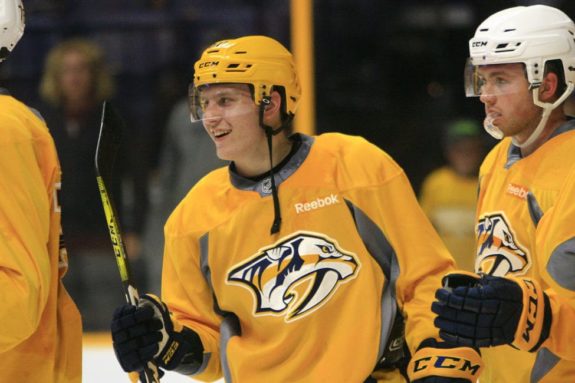
Although some of the luster has worn off since Eeli Tolvanen fell to the Predators at 30th in the 2017 Draft and he followed it up with a record-breaking KHL season, he remains an excellent prospect. I have to think that teams wanted him as the centerpiece in potential trades at the recent trade deadline, but general manager David Poile must believe enough in him to have held on to him. Perhaps that’s the reason the Predators didn’t acquire Matt Duchene or Mark Stone.
It makes sense to keep Tolvanen, especially since he has picked up his play in recent months, and that included February when he had three goals and three assists in 11 games. That gives him 10 goals and 21 points on the season, still not a great total, but he is only 19 playing in a league in which 24-year-olds make up the majority of players. Tolvanen has focused on his two-way game this season and his development is paying off. As the Predators’ top prospect, he’ll likely join Nashville in the postseason assuming the Admirals don’t reach the playoffs. He should also have an inside track to a top-six NHL role in 2019-20.
2. D Dante Fabbro, Boston University (January Rank: 2)
- Draft Information: 2016 1st Round (17th Overall)
- Season Stats: 31 GP, 6 G, 19 A, 4 PPG, 22 PIMs, 6.5 S%
- February Stats: 8 GP, 1 G, 3 A, 20 shots
The Boston University Terriers actually play one more game in February, a road matchup against eighth-ranked Providence University. However, in order to get this article published by the deadline, I am moving forward with the eight games they’ve played so far in February and will include the remaining game in March’s Growing Fangs. The same holds true for the other B.U. players.
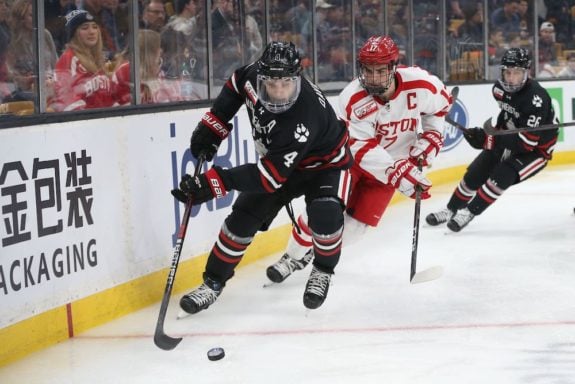
Fabbro, the Terriers’ junior captain and the Predators’ top defense prospect, continues to have an excellent season with 25 points in 31 games. He led the team in scoring for the majority of the season before he was recently surpassed by Joel Farabee, the Philadelphia Flyers’ first-round pick from 2018. Fabbro remains a great prospect and exhibits his two-way play that allows him lead the rush, quarterback the power play and shut down opponents in one-on-one situations.
As a junior, Fabbro will have a decision to make at season’s end: sign his entry-level contract with Nashville or return to B.U. for his senior season. TSN’s Bob McKenzie reported on Feb. 8 that Fabbro is expected to turn pro at season’s end. Joining the Predators means being a part of the team during their playoff run and likely getting time in on the third pair with Dan Hamhuis. It would also get him started on the path for a top-four role in the future.
3. F Rem Pitlick, University of Minnesota (January Rank: 8)
- Draft Information: 2016 3rd Round (76th Overall)
- Season Stats: 33 GP, 17 G, 21 A, 8 PPG, 24 PIMs, 16.5 S%
- February Stats: 8 GP, 2 G, 8 A, 21 shots
University of Minnesota junior Rem Pitlick is shooting up the prospects board thanks to an incredible 2018-19 season. He leads the Golden Gophers with 38 points in 33 games and has already surpassed his point totals from the past two seasons. As I’ve mentioned before, many thought he’d regress with former linemate Casey Mittelstadt going to the NHL, but that hasn’t been the case. In February, he added two goals and 10 points in eight games, further elevating his production.
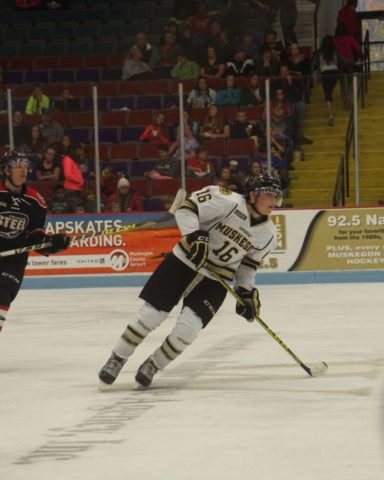
His shooting percentage is high at 16.5 percent, but he’s been at that level all season. Like Fabbro, look for Poile to push to get Pitlick signed this summer rather than risk losing him to free agency after his senior season. He’ll likely need an AHL season before jumping to the NHL, but the 5-foot-9 forward has all the necessary skills to be a future Predator. With his size, vision, skating and scoring acumen, think Viktor Arvidsson-lite.
4. F Laurent Dauphin, Milwaukee Admirals (January Rank: Unranked)
- Draft Information: 2013 2nd Round (39th Overall) by the Phoenix Coyotes
- Season Stats: 42 GP, 7 G, 17 A, 2 PPG, 42 PIMs, 8.4 S%
- February Stats: 10 GP, 1 G, 4 A, 15 shots
As mentioned in the introduction, the Predators acquired Dauphin from the Coyotes in exchange for Pettersson. Losing Pettersson was tough as he led the Admirals in scoring at that time. He also appeared to be on the verge of an NHL call-up. However, he was already 25 and was likely to only top out as a bottom-six forward for the Predators. Meanwhile, Dauphin is 23, has the pedigree as a second-round draft pick and was better than a point-per-game player his last two QMJHL seasons.
Although he only has 35 games of NHL experience, Dauphin still has the potential to develop into a productive NHL-er. At five-on-five, he and Pettersson have been similar players this season. Pettersson may have a slight edge in goals-per-game and points-per-game, but Dauphin has the higher primary assists-per-game and shots-per-game.
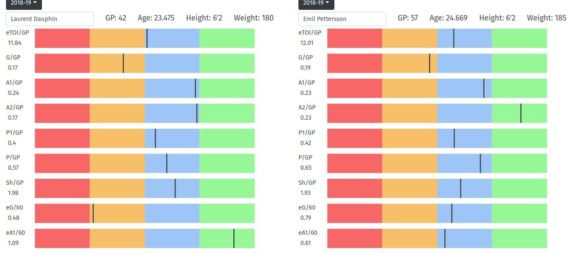
In total, Dauphin has seven goals and 24 points on the season with one goal and five points in February. He has been a contributor in his eight games with Milwaukee and looks to be a solid addition to the prospect pool.
5. D Frédéric Allard, Milwaukee Admirals (January Rank: 4)
- Draft Information: 2016 3rd Round (78th Overall)
- Season Stats: 48 GP, 3 G, 20 A, 1 PPG, 32 PIMs, 3.2 S%
- February Stats: 5 GP, 0 G, 0 A, 11 shots
As I’ve mentioned in recent Growing Fangs, I’m a fan of defenseman Frédéric Allard. He recently turned 21, so he’s still young for a blueliner, and is only point away from tying his 2017-18 total. In his second AHL season, Allard has stepped up his two-way play. He’s best known as defenseman who’s unafraid to jump up on the rush while still playing solid defense.
He has three goals and 23 points on the season, both solid numbers for the position, but he’s only shooting 3.2 percent, so there’s room for growth. He had a rough February, having only played in five of the team’s 11 games due to injury and went pointless in the games he did play in, but his absence was clearly felt as the Admirals failed to win any games in the month. His turnover against the Cleveland Monsters on Feb. 24 directly led to a goal, highlighting his defensive struggles this month. His potential as a future NHL blueliner remains.
6. D Alexandre Carrier, Milwaukee Admirals (January Rank: 5)
- Draft Information: 2015 4th Round (115th Overall)
- Season Stats: 57 GP, 3 G, 18 A, 1 PPG, 41 PIMs, 3.5 S%
- February Stats: 11 GP, 1 G, 1 A, 13 shots
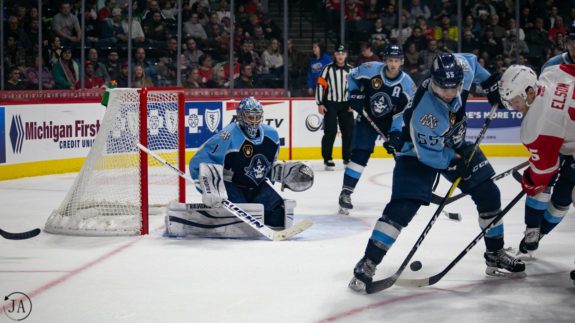
Fellow blueliner Alexandre Carrier is one year older and was drafted one round later than Allard. Carrier has struggled this season, both offensively and defensively. His three goals and 21 points represent a scoring regression for the second straight season. He’s also a negative in the plus/minus department for the third straight season.
Has his development plateaued? If so, he’s unlikely to be anything more than an AHL defenseman. Luckily, he is still only 22 years old and a lot of defensemen don’t even break into the NHL until his age or later. However, his on-ice struggles will continue to see him fall down the prospect rankings.
7. F Anthony Richard, Milwaukee Admirals (January Rank: 6)
- Draft Information: 2015 4th Round (100th Overall)
- Season Stats: 54 GP, 18 G, 19 A, 4 PPG, 14 PIMs, 16.2 S%
- February Stats: 11 GP, 1 G, 5 A, 14 shots
Anthony Richard earned a cup of coffee with Nashville earlier this season as a 22-year-old. It was his NHL debut and he played one game and didn’t find the scoresheet. At the AHL level, he led the Admirals in scoring for much of the season until he was passed by Pettersson and now Helewka, although Richard has more points with Milwaukee.
He is an interesting player. In the QMJHL, he had 91 and 87 points in his final two seasons and has improved each of his three seasons in the AHL. He started with four goals and 16 points as a rookie in 2016-17 and currently has 18 goals and 37 points. He is shooting 16.2 percent, which is quite high, but he has also increased his shooting percentage in each AHL season, starting at 5.1 percent in 2016-17.
It’s difficult to determine what Richard’s ceiling is, but it should be in some NHL role, likely in the bottom-six. For comparison’s sake, his 37 points in 54 games this season are comparable to what Calle Järnkrok, Colton Sissons and Austin Watson did in their best AHL seasons.
8. F Yakov Trenin, Milwaukee Admirals (January Rank: 9)
- Draft Information: 2015 2nd Round (55th Overall)
- Season Stats: 56 GP, 11 G, 12 A, 2 PPG, 29 PIMs, 12.5 S%
- February Stats: 10 GP, 4 G, 0 A, 9 shots
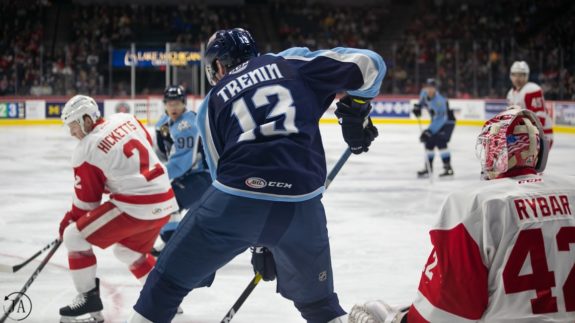
Russian forward Yakov Trenin has turned his season around to reach the 11 goals and 12 assists he currently has. From the start of the season through the end of 2018, he had three goals and and six assists. Since then, eight goals and six assists. His shooting percentage has also rebounded this season to 12.5 percent, nearly six points higher than the 6.7 percent he shot last season. He kept up his hot play in February with four goals on nine shots, so it’s clear he is an accurate shooter.
He is shooting less than he did last season, 1.57 shots-per-game in 2018-19 compared to 1.70 in 2017-18, hence the higher shooting percentage. That leads to the question of whether he’s being selective on where he shoots from or isn’t generating as much offense. I think it’s the former as his expected goals-per-60 are at .94 in 2018-19, up from .62 last season.
If he continues to generate offense at this rate, in addition to the fact that he’s only 22, it’s hard not seeing him breaking into the NHL at somepoint. It also helps that he’s worked on his defensive game as evident by his team-leading plus-13 this season.
9. F Patrick Harper, Boston University (January Rank: 7)
- Draft Information: 2016 5th Round (138th Overall)
- Season Stats: 31 GP, 4 G, 14 A, 6 PIMs, 9.8 S%
- February Stats: 8 GP, 2 G, 1 A, 8 shots
It’s a shame that a mysterious illness ended Patrick Harper’s 2017-18 season and has seemingly continued to affect him this season. The B.U. junior was better than a point-per-game player before his season was shut down and he hasn’t been the same player in 2018-19. He does still have upside, however, and there are occasions when he shows it.
Take a look at the clip below as an example. He generates a high-danger scoring chance by passing the puck to a streaking teammate that almost results in a goal. He then rejoins the cycle by positioning himself near the hash marks before finding a soft spot in coverage and jamming home a rebound. That’s an NHL-style goal and is reminiscent of many scored by the Predators in recent seasons.
Here's Harper's goal that made it 4-1. #GoBU pic.twitter.com/z4B4MYMH74
— BU Men's Hockey (@TerrierHockey) January 21, 2019
Although he’s a junior, it is likely up in the air as to whether he signs after his season ends. His illness calls into question his future given how long it’s taken him to rebound, yet the potential remains. Another collegiate season, particularly a healthy one, could greatly help his game, but in doing so, the Predators risk losing him to free agency.
10. F Jáchym Kondelík, University of Connecticut (January Rank: Unranked)
- Draft Information: 2018 4th Round (111th Overall)
- Season Stats: 31 GP, 4 G, 21 A, 12 PIMs, 6.3 S%
- February Stats: 7 GP, 1 G, 2 A, shot stats unknown
I doubt anyone expected Jáchym Kondelík to do what he’s done this season. As a freshman, his 25 points are second on his team and he’s tied for sixth in scoring among NCAA freshmen. And he’s doing all of this while playing center on a bad University of Connecticut team (10-20-2 record). His production slowed down in February with one goal and two assists in seven games, but UConn did play three games against ranked opponents.
At 6-foot-7, he would be the tallest player on the Predators this season. Yet, despite his size, he hasn’t always used his body to his advantage, something he’s worked on this season by adding muscle to his frame. Fourth-round picks are typically long-shots to make the NHL, and Kondelík may still be one, but if his first collegiate season is any indication, he has a good future ahead of him. If he continues developing as he has, he’ll continue climbing the Predators prospect rankings and eventually be a nightmare for opponents in the NHL.
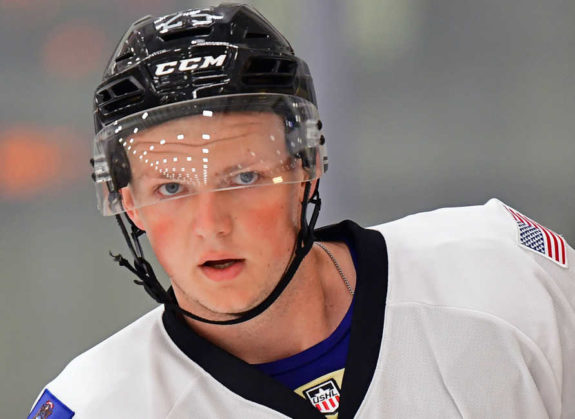
Outside Top-10, But Knocking on the Door
D David Farrance, Boston University (January Rank: 10)
- Draft Information: 2017 3rd Round (92nd Overall)
- Season Stats: 30 GP, 4 G, 13 A, 2 PPG, 19 PIMs, 7.3 S%
- February Stats: 7 GP, 0 G, 3 A, 8 shots
If sophomore defenseman David Farrance has a future as a regular NHL-er, it will be as an offensive defenseman. He is highly skilled in terms of leading rushes and generating scoring chances, but struggles defensively. That being said, he is still young at 19 years of age. Regardless of how his defensive game develops, he has to get more consistent. He and Fabbro were expected to form B.U.’s top pair this season, but the team’s struggles have led to inconsistent play from both.
Farrance had five points in January, a good month for him, but he has followed it up with three points (all assists) in seven games in February. He also sat out one of the back-to-back games versus the University of Vermont. For him to succeed, he needs to be devoted to generating offense. This includes shooting the puck as much as possible to create rebounds, garner deflections and, obviously, score goals. It’s realistically his only path to the NHL at this moment as his defensive game isn’t strong enough.
F Adam Helewka, Milwaukee Admirals (January Rank: Unranked)
- Draft Information: 2015 4th Round (106th Overall) by the San Jose Sharks
- Season Stats: 49 GP, 17 G. 22 A, 6 PPG, 20 PIMs, 20.0 S%
- February Stats: 10 GP, 5 G, 4 A, 19 shots
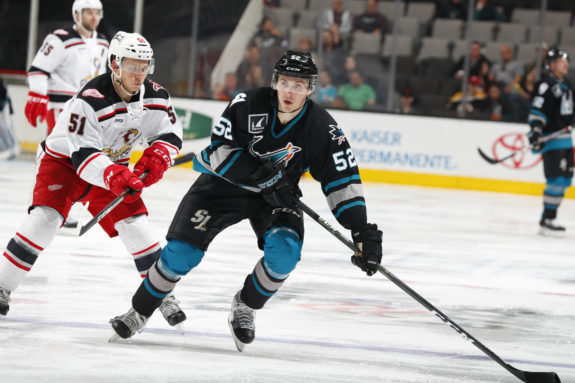
Helewka, the other player acquired for Pettersson, is also 23 years old and is having a wonderful season. He leads the team in points, although he only has eight with the Admirals. In his third AHL season, he has already surpassed his goal and point totals from his first two seasons. He is shooting 20 percent, which is unsustainably-high, but it’s a product of him only attempting 1.73 shots-per-game. So again, he could be a selective shooter or he could struggle to generate offense.
Based on his 55 goals for percentage when he was a member of the Tucson Roadrunners, the Coyotes’ AHL affiliate, I’d say it’s again the former. He has an expected goal rate of 1.16 per-60 and an expected primary assist rate of .87 per-60 this season, both which rate him as a first line AHL forward. What’s alarming is that his goals for percentage has dropped from 55 to 47.5 percent with the Admirals, a testament to how bad they are this season.
Considering both he and Dauphin signed one-year, two-way extensions with the Predators, it’s obvious that both are in someway part of the team’s future plans. How much a part of them, only time will tell. Both have high upsides and have age on their side.
F Tommy Novak, University of Minnesota (January Rank: Unranked)
- Draft Information: 2015 3rd Round (85th Overall)
- Season Stats: 33 GP, 3 G, 15 A, 2 PPG, 2 PIMs, 4.1 S%
- February Stats: 8 GP, 1 G, 4 A, 17 shots
Pitlick’s teammate Tommy Novak has turned it on of late with one goal and four assists in eight games in February. That gives him three goals and 18 points on the season, not a great total, and still below his scoring rates from the past three seasons. He’s also a minus-15 on the season, which although plus/minus doesn’t accurately reflect a player’s abilities, his is an alarmingly bad number. However, two penalty minutes across 33 games shows how smart he is without the puck.
Tommy Novak puts @GopherHockey back in front!
📺: https://t.co/NlrfMS6E6Q pic.twitter.com/o9Wg2yP3Le
— Bally Sports North (@BallySportsNOR) February 3, 2019
Novak still possesses an excellent release and runs point on the power play as shown in the above video. He’s also got good size at 6-foot-1 and will need to continue his strong play the remainder of the season to earn a contract this summer. Whether that contract will come from the Predators or another team, only time will tell.
Let me know in the comments below what your thoughts are on Nashville’s farm system, individual prospects and how I ranked them.
*All stats from EliteProspects, the American Hockey League, individual team sites and Prospect-Stats